United States Fish and Wildlife Service

United States Fish and Wildlife Service: Publications
Date of this Version
Fall 2005
Citation
Wildlife Society Bulletin (Autumn 2005) 33(3): 842-850
Abstract
We evaluated translocation as a method to promote recovery of black-tailed prairie dogs (Cynomys ludovicianus) after plague-induced population declines in colonies at the Charles M. Russell National Wildlife Refuge, Montana. We translocated prairie dogs in June of 1999 and evaluated the effects of translocation on colony area 1 year and 4 years later. We also assessed effects of release group size and estimated rates of population growth and survival. Initial size of experimental colonies was categorized as inactive (0 ha), small (0.1-2.0 ha), or large (2.0-6.6 ha); numbers of prairie dogs translocated to each colony size class were 0 (control), 60, and 120. Among inactive colonies, the control remained inactive and the colony receiving 60 prairie dogs grew to 1.5 ha by 2000 and after a second release in 2002 was 1.9 ha in 2003. The colony receiving 120 grew to 3.3 ha by 2000 and decreased to 2.6 ha by 2003. Patterns on small and large colonies after 1 year were less dramatic, but in each case the proportional increase in colony area was lowest on the control and high- est on the colony receiving 120 prairie dogs. Patterns were more difficult to discern 4 years after translocations. It appears that as large colonies approach historic size, area growth decreases and is slower than on small colonies. Experimental colonies grew 24.6 ha (315%) by 2000 and 72.1 ha (924%) in 4 years compared to non-experimental colonies of similar size that grew 6.5 ha (23%) in 1 year and 26.5 ha (93%) by 2003. Monthly survival rates of prairie dogs during the first 3 months following translocation were higher on large colonies (0.79, 95% Cl=0.75-0.82) than on small (0.67, 95% CI=0.62-0.72) or inactive colonies, (0.63, 95% Cl=0.57-0.68). Monthly survival rates were relatively high (0.88-1.0) during subsequent intervals and did not vary among initial colony size classes. Recapture rates for all colonies were higher during the fall trapping session (0.83, 95% Cl=0.76-0.90) than in the winter (0.59, 95% CI=0.49-0.69). Translocation was effective for restoration of prairie dog populations, particularly on inactive colonies.


Comments
United States government work